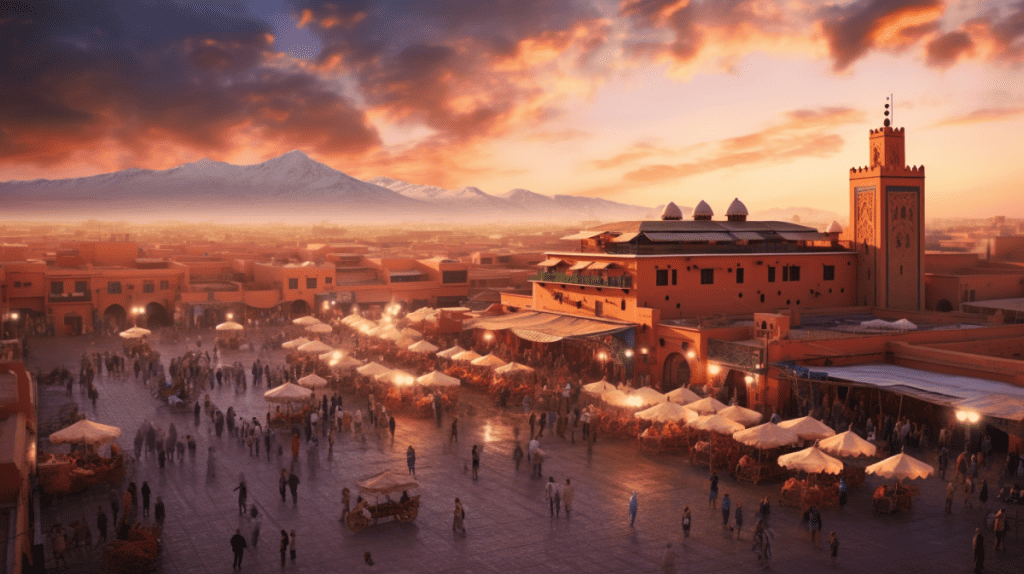Marrakech Walls, built in the 12th century, are emblematic of Morocco’s rich history. Encircling the old city, these red sandstone fortifications stretch over 19 km and feature 202 bastions and 20 gates. Originally erected to defend Marrakech, they now stand as a testament to the city’s storied past.

Design of the Marrakech Walls
The walls exhibit a consistent structure reminiscent of medieval designs found in Morocco and al-Andalus. Ranging from 6 to 8 meters tall, they are bolstered by square towers or bastions every 25 to 30 meters. The walls’ thickness oscillates between 1.4 and 2 meters, and the towers are between 8 and 14 meters thick. In earlier times, a narrow pathway crowned the walls, guarded by battlements with merlons. Many of these structures no longer exist. Historical traces suggest the presence of a ditch or moat encircling the walls, although its defensive significance might have been minimal.
Construction & Maintenance
The Marrakesh walls, akin to those in Fes and other historic Moroccan cities, were constructed using rammed earth, a time-honoured method prevalent across the Near East, Africa, and beyond. Commonly referred to as “pisé” in French or “tabia” in Arabic, this technique was cost-effective and relatively efficient, employing local materials like mud, soil, straw, or lime for better adhesion. Marrakesh walls contain up to 17% lime, in contrast to Fes and Meknes walls which have up to 47%. The method persists today, though material ratios have evolved due to cost dynamics.
Construction involved layering. Material was compacted into sections, each 50-70 cm long, held by wooden boards. Once set, the boards were removed, and the next level began. This technique often left visible rows of tiny holes. Sometimes, walls were coated with lime or stucco for a smoother finish and enhanced protection.
However, these walls required constant care due to their susceptibility to rain erosion. In areas near the Sahara, structures without durable composition, often missing lime, deteriorate rapidly if abandoned. Hence, while some wall portions appear newly restored, others are in decay.
History of the Marrakech Walls
Almoravids (11th – 12th Centuries)
In 1070, the Almoravid leader, Abu Bakr ibn Umar, founded Marrakesh. Initially, its primary fortification was the Ksar al-Hajjar (“Palace/Fortress of Stone”), a citadel constructed next to where the Kutubiyya Mosque now stands. As the first significant Almoravid structure, this citadel symbolized their shift from nomadic to settled life.

By 1126, a subsequent Almoravid amir, Ali ibn Yusuf, felt the need for greater defences, likely due to the rising Almohad threat. Influenced by Abu-l-Walid ibn Rushd, a Cordoban qadi and grandfather to the renowned Ibn Rushd (Averroes), he initiated the city’s surrounding walls. Interestingly, these walls, completed in early 1127, were reportedly built in just 8 months at a cost of 70,000 gold dinars. Before construction, astrologers were consulted for an auspicious start date, and ropes mapped out the walls’ path.
Much of today’s medina walls still follow the Almoravid blueprint, albeit with modifications to the north and south. The design, resembling a slightly irregular quadrangle, may have been influenced by existing sacred sites or spontaneous decisions to encompass more land. Notably, many current city gates trace back to this era, either in position or original form. Among them are Bab Fes, Bab Debbagh, and Bab Aghmat, to name a few. Some gates, such as Bab ash-Shari’a and Bab Moussoufa, no longer exist but are documented in historical texts or remnants.
Almohad Era (12th – 13th Centuries)
When Abd al-Mu’min, the Almohad leader, took Marrakesh in 1147, he razed numerous Almoravid structures, particularly mosques. Yet, the Ksar el-Hajjar and Ali ibn Yusuf’s palace remained, serving as the Almohad rulers’ official residences for a period. Ya’qub al-Mansur, the Almohad caliph reigning from 1184-1199, initiated an expansive construction campaign to establish the Kasbah, a new royal district attached to the city’s southern side. This expansion, completed between 1185 and 1190, was driven by Marrakesh’s burgeoning population and the need for more urban space. Al-Mansur might also have been inspired by other influential Islamic leaders who built distinct palace-cities, reminiscent of the Ummayyad’s Madinat al-Zahra near Cordoba or the Abbasid’s Samarra in Iraq.

Today, the Kasbah’s current western and southern boundaries, including its fortifications, largely reflect the original Almohad design. Its primary entrance, Bab Agnaou, functioned as both a defensive structure and a ceremonial gateway. Located near the city wall adjacent to Bab er-Robb, it provided the primary access point into the Kasbah for the inhabitants of Marrakesh. The Almohads also introduced expansive gardens near the Kasbah, notably the al-Buhayra garden, now recognized as the Agdal Gardens, set apart by their distinct fortifications.
The Saadian and Alaouite Era (15th Century)
After the Almohad era, Marrakesh experienced a period of decline as the subsequent Marinid dynasty shifted their focus to Fes, their new capital. The city’s resurgence came with the Saadian Dynasty in the 16th century. They not only made Marrakesh their capital but also embarked on significant construction. The Saadians revamped the Kasbah, extending its northern perimeters with new palaces such as El Badi. Sultan Moulay Abdallah al-Ghalib moved the Jewish community to a new Mellah district, further expanding the kasbah. Sultan Ahmad al-Mansur rejuvenated and expanded the Agdal Gardens.
Subsequent rulers, particularly from the Saadian and Alaouite dynasties, commissioned the development of the zawiya and mosque complex near the mausoleum of Sidi Bel Abbes, located beyond the city’s northern gate, Bab Taghzout. Recognized as Marrakesh’s patron saint, Sidi Bel Abbes’ zawiya became a magnet for settlers, resulting in a thriving neighbourhood outside the city’s walls. By the 18th century, under Alaouite sultan Muhammad ibn Abdallah, the city’s walls were extended to encompass this area, marking the city’s new northern boundary. Concurrently, he merged the Kasbah and Agdal boundaries.
Additionally, the Alaouite sultans further enhanced the city’s walls and gates. Sultan Muhammad ibn Abdallah played a pivotal role in rejuvenating the royal palace (Dar al-Makhzen) after periods of neglect, crafting its contemporary appearance. The Kasbah’s southern side was broadened to house gardens, residential areas for palace workers and military, and a series of walled squares known as mechouars. Numerous gates were added, with Bab Ahmar showcasing a distinctive design featuring an elevated platform for artillery. After the Rehamna destroyed the Agdal Gardens’ western wall in 1862, Sultan Muhammad ibn Abd al-Rahman rebuilt it, also adding the Sqallat al-Mrabit fort to safeguard these fortifications.
Gates of the Marrakech Walls
The primary gates of Marrakesh, excluding those of the Kasbah, originate from the Almoravid era when the city’s fortifications were first established. However, throughout the years, many of these structures have been altered or refurbished. In medieval times, a significant number of these gates featured intricate “bent entrances” which were strategically designed to enhance their defensive capabilities.[2] In contemporary times, to facilitate smoother traffic flow into and out of the medina, straightforward archways have been introduced adjacent to several of these historical gates. Moreover, to cater to modern infrastructural needs, new openings have been created in the city walls to accommodate the development of roads.
Sources
- “The Stories Behind Marrakech’s City Gates.” Culture Trip. Accessed [13.09.23]. https://theculturetrip.com/africa/morocco/articles/the-stories-behind-marrakechs-city-gates/
- “Walls of Marrakesh.” Wikipedia. Last modified [10.09.23]. https://en.wikipedia.org/wiki/Walls_of_Marrakesh.




